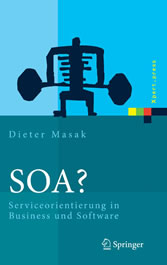Suchen und Finden
Danksagung
6
Inhaltsverzeichnis
7
1 Prolog
11
2 Einleitung
13
2.1 Services
15
2.2 SOC und SOSE
16
2.3 Heutiger Zustand
17
2.4 SOA
18
3 Serviceorientierungsparadigma
23
3.1 Paradigma
26
3.2 Service
26
3.3 Enterprise Architekturen
30
3.4 Zachman-Framework
31
3.5 TOGAF
37
3.6 Systemtheorie
40
4 Service Oriented Enterprise
41
4.1 Entwicklungsstadien einer Organisation
42
4.2 Virtuelle Enterprises
50
4.3 Service Oriented Enterprise
58
4.4 Consumerorganisation
71
4.5 Providerorganisation
74
4.6 Brokerorganisation
82
4.7 Serviceadoption
83
4.8 Serviceentwicklung
84
4.9 Serviceportfoliomanagement
85
4.10 Geschäftsprozess
87
4.11 Organisations übergreifende Prozesskoordination
89
4.12 Reifegradmodell
91
4.13 Governance
93
4.14 Auswirkungen
95
5 Service Oriented Architecture
97
5.1 SOA-Layer
103
5.2 Eventarchitektur
106
5.3 Services
108
5.4 Servicemodell
111
5.5 Komposition
114
5.6 Quality of Service
118
5.7 Policy
121
5.8 Servicearten
122
5.9 Webservices
125
5.10 Präsentationsservices
130
5.11 SOAbility
134
5.12 Reifegradmodelle
139
5.13 SOA-Governance
143
5.14 Herausforderungen
145
6 Service Oriented Platform
149
6.1 Komponenten
151
6.2 Broker Architekturen
153
6.3 Enterprise Service Bus
156
6.4 Servicecontainer
175
6.5 Service Information Management
181
7 Geschäftsprozess
184
7.1 Geschäftsprozess
185
7.2 Geschäftsprozessmanagement
189
7.3 Transaktionen
190
7.4 Softwareunterstützung
194
8 Service Oriented System Engineering
200
8.1 Evolution und Komplexität
203
8.2 Vorgehensmodelle
211
8.3 Bricolage
215
8.4 Language-Action Perspektive
217
8.5 SOS-Zyklus
219
8.6 Organisations übergreifende Komposition
221
8.7 Reengineering
222
8.8 Ähnlichkeit
224
8.9 Entwicklungsstrategien
225
8.10 Taxonomien
226
8.11 Ontologie
227
8.12 OWL-S
233
8.13 WSMO
235
8.14 WSDL-S
237
8.15 Ausbildung
237
9 Service Oriented Computing
240
9.1 Standards
244
9.2 XML
247
9.3 SOAP
248
9.4 WSDL
250
9.5 UDDI
252
9.6 WSIL
255
9.7 BPEL
256
9.8 WSCI
262
9.9 BPML
265
9.10 WS-CDL
266
9.11 Semantische Services
269
9.12 RosettaNet
271
9.13 ebXML
274
9.14 ebBPSS
276
9.15 Servicemodellierung
278
9.16 Wiederverwendung
287
9.17 Servicemaintenance
290
9.18 Servicekomposition
291
9.19 Serviceinteroperabilität
296
9.20 Transaktionen
299
9.21 -Kalkül
303
10 Ultra Large Scale Systems
306
10.1 Charakteristika
308
10.2 Treibende Kräfte
311
10.3 Herausforderungen
312
11 Systemtheorie
314
11.1 Komplexe Systeme
317
11.2 Enge Koppelung
322
11.3 Ashby-Conant-Theorem
324
11.4 Organisationen
327
11.5 Rekursionen
328
11.6 Selbstorganisation
329
11.7 Autopoiesis
331
11.8 Unbeherrschbarkeit
332
11.9 SOA
334
11.10 Skalenfreie Netzwerke
335
12 Viable System Model
340
12.1 Viable System Service
350
12.2 VSM-Design
354
12.3 Kontrollerdesign
357
12.4 Adaption
360
13 Epilog
361
A Metriken
364
A.1 Messbarkeit
365
A.2 Rating
366
A.3 Netzwerkmaße
366
A.4 Komplexitätsmaße
367
A.5 Koppelungsmaße
370
A.6 Semantische Ähnlichkeit
371
B -Kalkül
373
B.1 Definition
373
B.2 Kongruenz
374
B.3 Abstraktion
375
B.4 Reaktion
375
B.5 Replikation
376
B.6 Transaktionen
376
Literaturverzeichnis
379
Sachverzeichnis
383
Alle Preise verstehen sich inklusive der gesetzlichen MwSt.









